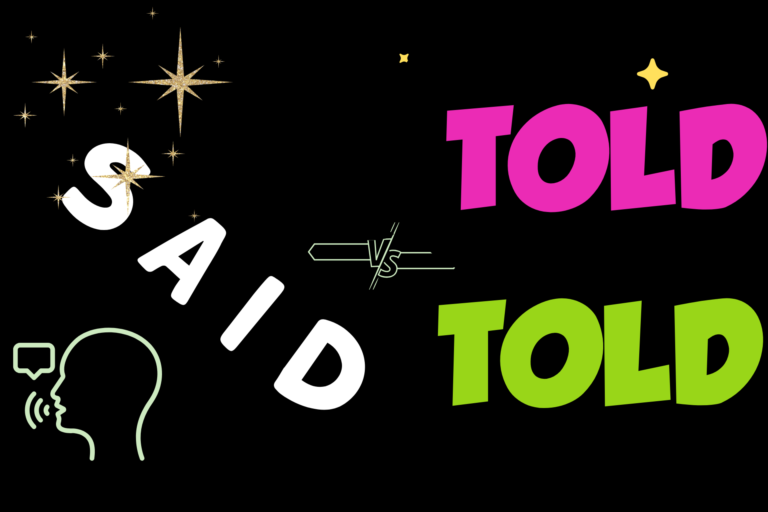Introduction
Said vs. told are two commonly confused verbs in English, often misused by both learners and native speakers. While both refer to speech, they have distinct rules for usage. Understanding these differences is essential for clear and correct communication. This article explains when to use ‘said’ and ‘told’ correctly, provides 15 clear examples, and highlights five common misuse cases for both.
When to Use ‘Said’
‘Said’ is used when reporting speech without specifying the listener. It is typically followed by direct or indirect speech and does not require an object.
Rules for Using ‘Said’:
- Use ‘said’ when quoting or paraphrasing speech without naming the listener.
- It can be followed by a clause (e.g., “He said he was coming”).
- It is often used in narratives to indicate dialogue.
Examples of ‘Said’ in Sentences:
- She said she would arrive by noon.
- “I love reading,” he said with a smile.
- The teacher said that the test would be difficult.
- They said it was too late to join the event.
- “This is amazing,” she said excitedly.
- He said he had never seen such a beautiful sunset.
- My friend said the weather was perfect for hiking.
- “I need some time to think,” she said thoughtfully.
- The doctor said the patient was recovering well.
- He said, “I can’t believe how fast time flies.”
- The news anchor said the storm would hit tonight.
- She said she would call me later.
- “I’m sorry for being late,” John said sincerely.
- The scientist said the discovery was groundbreaking.
- They said they had a great time at the concert.
When to Use ‘Told’
‘Told’ is used when specifying who was spoken to. It always requires an object (the person being spoken to) and usually follows the structure ‘told + object + information’.
Rules for Using ‘Told’:
- Use ‘told’ when mentioning the listener.
- It cannot be followed by direct speech (use ‘said’ for that).
- It is commonly followed by an object and a clause.
Examples of ‘Told’ in Sentences:
- She told me she would arrive by noon.
- He told his friend about the surprise party.
- They told us the meeting had been postponed.
- My mother told me to be careful.
- She told the students to submit their assignments on time.
- The manager told his employees about the new policy.
- I told her that I would help.
- He told them to wait outside.
- The doctor told me to take the medicine twice a day.
- She told her colleague about the new project.
- They told their children a bedtime story.
- He told the waiter his order.
- The coach told the players to give their best effort.
- I told my parents about my new job.
- She told her sister that she was moving abroad.
Common Misuse of ‘Said’ and ‘Told’
Many learners struggle with distinguishing when to use ‘said’ or ‘told’. Below are five common mistakes for each and how to correct them.
Common Mistakes with ‘Said’:
- Incorrect: She said me that she was tired.
Correct: She told me that she was tired. - Incorrect: He said to call him later.
Correct: He told me to call him later. - Incorrect: They said us about the party.
Correct: They told us about the party. - Incorrect: She said me to wait.
Correct: She told me to wait. - Incorrect: The teacher said to us that the exam is tomorrow.
Correct: The teacher told us that the exam is tomorrow.
Common Mistakes with ‘Told’:
- Incorrect: She told, “I will be there soon.”
Correct: She said, “I will be there soon.” - Incorrect: He told, “This is a great opportunity.”
Correct: He said, “This is a great opportunity.” - Incorrect: They told that they were leaving early.
Correct: They said that they were leaving early. - Incorrect: She told, “I don’t understand.”
Correct: She said, “I don’t understand.” - Incorrect: He told he was not coming.
Correct: He said he was not coming.
Key Takeaway
Understanding the difference between said vs. told can improve communication and writing clarity. Remember:
- Use ‘said’ when reporting speech without naming the listener.
- Use ‘told’ when specifying who was spoken to.
- ‘Told’ always requires an object, while ‘said’ does not.
By remembering these rules and practising with examples, mastering said vs. told will become second nature.
Click below to learn more, and boost your confidence in communication.
https://fluent-eng.com/italian-leisure-aperitivo-sunday-feasts-and-style/

